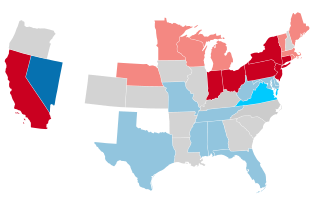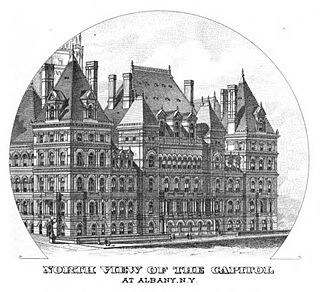
The 1882 New York state election was held on November 7, 1882, to elect the governor, the lieutenant governor, the chief judge and a U.S. Representative-at-large, as well as all members of the New York State Assembly. Besides, two constitutional amendments were proposed - the abolition of tolls on the State canals, and to increase the number of justices on the New York Supreme Court - and were accepted by the electorate.

The 1878 New York state election was held on November 5, 1878, to elect a judge of the New York Court of Appeals, as well as all members of the New York State Assembly and one member of the New York State Senate to sit in the 102nd New York State Legislature.

The 1863 United States Senate election in New York was held on February 3, 1863, by the New York State Legislature to elect a U.S. Senator to represent the State of New York in the United States Senate.

The 1867 United States Senate election in New York was held on January 15, 1867, by the New York State Legislature to elect a U.S. Senator to represent the State of New York in the United States Senate. Incumbent Senator Ira Harris was not renominated for a second term in office. U.S. Representative Roscoe Conkling was elected to succeed him.

The 1873 United States Senate election in New York was held on January 21, 1873, by the New York State Legislature to elect a U.S. Senator to represent the State of New York in the United States Senate.

The 1875 United States Senate election in New York was held on January 19 and 20, 1875, by the New York State Legislature. The legislature, with a Republican Senate and Democratic Assembly, jointly elected Democrat Francis Kernan Senator. Kernan became the first Democrat to represent New York since 1851.

The 1881 United States Senate election in New York was held on January 18, 1881, by the New York State Legislature to elect a U.S. Senator to represent the State of New York in the United States Senate.
The 1881 United States Senate special elections in New York was held from May 31 to July 22 by the New York State Legislature to elect two U.S. senators to represent New York in the United States Senate. The elections were triggered by the May 16 resignations of Senators Roscoe Conkling and Thomas C. Platt, triggered by ongoing disputes with President James A. Garfield over federal patronage privileges in the state, particularly the lucrative postings at the New York Customs House. The resignations were intended to trigger the Senators' re-elections to affirm their support in the New York Legislature as a show of either popularity or political force. Instead, the legislature demurred for 52 days before electing Warner Miller and Elbridge Lapham in their place. During the balloting, President Garfield was shot; he died two months after balloting concluded.
The 1885 United States Senate election in New York was held on January 20, 1885, by the New York State Legislature to elect a U.S. Senator to represent the State of New York in the United States Senate.

The 1872–73 United States Senate elections were held on various dates in various states, coinciding with President Ulysses S. Grant's re-election. As these U.S. Senate elections were prior to the ratification of the Seventeenth Amendment in 1913, senators were chosen by state legislatures. Senators were elected over a wide range of time throughout 1872 and 1873, and a seat may have been filled months late or remained vacant due to legislative deadlock. In these elections, terms were up for the senators in Class 3.

The 1874–75 United States Senate elections were held on various dates in various states. As these U.S. Senate elections were prior to the ratification of the Seventeenth Amendment in 1913, senators were chosen by state legislatures. Senators were elected over a wide range of time throughout 1874 and 1875, and a seat may have been filled months late or remained vacant due to legislative deadlock. In these elections, terms were up for the senators in Class 1.

The 1878–79 United States Senate elections were held on various dates in various states. As these U.S. Senate elections were prior to the ratification of the Seventeenth Amendment in 1913, senators were chosen by state legislatures. Senators were elected over a wide range of time throughout 1878 and 1879, and a seat may have been filled months late or remained vacant due to legislative deadlock. In these elections, terms were up for the senators in Class 3.

The 1880–81 United States Senate elections were held on various dates in various states, coinciding with the presidential election of 1880. As these U.S. Senate elections were prior to the ratification of the Seventeenth Amendment in 1913, senators were chosen by state legislatures. Senators were elected over a wide range of time throughout 1880 and 1881, and a seat may have been filled months late or remained vacant due to legislative deadlock. In these elections, terms were up for the senators in Class 1.

The 1884–85 United States Senate elections were held on various dates in various states, coinciding with the presidential election of 1884. As these U.S. Senate elections were prior to the ratification of the Seventeenth Amendment in 1913, senators were chosen by state legislatures. Senators were elected over a wide range of time throughout 1884 and 1885, and a seat may have been filled months late or remained vacant due to legislative deadlock. In these elections, terms were up for the senators in Class 3.

The 1866–67 United States Senate elections were held on various dates in various states. As these U.S. Senate elections were prior to the ratification of the Seventeenth Amendment in 1913, senators were chosen by state legislatures. Senators were elected over a wide range of time throughout 1866 and 1867, and a seat may have been filled months late or remained vacant due to legislative deadlock. In these elections, terms were up for the senators in Class 3.

The 96th New York State Legislature, consisting of the New York State Senate and the New York State Assembly, met from January 7 to May 30, 1873, during the first year of John A. Dix's governorship, in Albany.

The 100th New York State Legislature, consisting of the New York State Senate and the New York State Assembly, met from January 2 to May 24, 1877, during the first year of Lucius Robinson's governorship, in Albany.

The 101st New York State Legislature, consisting of the New York State Senate and the New York State Assembly, met from January 1 to May 15, 1878, during the second year of Lucius Robinson's governorship, in Albany.

The 102nd New York State Legislature, consisting of the New York State Senate and the New York State Assembly, met from January 7 to May 22, 1879, during the third year of Lucius Robinson's governorship, in Albany.

The 104th New York State Legislature, consisting of the New York State Senate and the New York State Assembly, met from January 4 to July 23, 1881, during the second year of Alonzo B. Cornell's governorship, in Albany.













